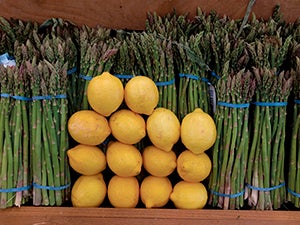Get out of the house to make delicious veggies
Published 9:44 am Sunday, August 27, 2017
By Megan Groh
Hy-Vee Dietitian
If your garden is anything like mine, then you’re frequently left wondering what to do with an overabundance of veggies.
At the rate my garden produces zucchini, I have had my fill for the season. I have eaten it raw, made zucchini noodles, zucchini turkey burgers, and zucchini bread. My favorite is to eat it grilled. When it comes to eating vegetables, raw or cooked really doesn’t seem to make a difference.
Keep reading to learn about preparing vegetables in a way that may just change all thoughts about eating them.
To get rave reviews for serving vegetables at the next meal, just try adding vegetables cooked on the grill. Grilling vegetables is a good way to meet the health goal of eating more vegetables. Why? The smoky smell and taste of vegetables cooked on the grill make them appealing to even the pickiest eater.
Common sense may lead us to think cooking decreases nutrients in vegetables. Interesting studies conducted at the Cornell University Department of Food Science by Rui Hai Liu determined cooking actually releases nutrients from the softened cell walls of many different vegetables. The release of these nutrients leads to better absorption and thereby contributes to better health.
For example, studies on human health suggest regular consumption of high levels of lycopene provides protection from certain cancers and may lower the risk of heart disease. When quartered tomatoes are cooked by simmering/roasting/grilling at 190-200 degrees for 30 minutes, the lycopene becomes up to 30 percent more concentrated and is more readily absorbed.
Research also indicates the availability of the antioxidants and phenolic acid in asparagus increases when asparagus spears are cooked.
Ready to give grilled vegetables a try? Here’s how to do it: Take your favorite vegetable(s) and clean, trim, then cut into bite-sized pieces, or leave whole. Prepare sturdy salad greens (such as romaine, kale, baby bok choy or small head lettuces like butter lettuce) by cutting in half or quarters.
Oil the grill rack or grill basket by using a paper towel dipped in olive or vegetable oil that is wiped over the surfaces where the food will touch. Do not use cooking sprays.
Next, toss the prepared vegetables in olive, corn or your favorite flavor-infused oil or drizzle the oil on the flat surface of lettuces to be grilled.
Grill salad greens with the cut side down until smoky and wilted. Grill other vegetables by first considering the density of each. Potatoes, for instance, will require a longer grilling time than asparagus or tomatoes. If you choose a mixture of vegetables, start by grilling the more dense choices until almost tender, then add the rest of the vegetables until desired tenderness is reached, turning as needed for even cooking and browning.
Using skewers or a grill basket is another option for perfectly grilled vegetables.
 Grilled Asparagus Salad with Citrus Dressing
Grilled Asparagus Salad with Citrus Dressing
All you need
•2 pounds asparagus (about 2 bunches), washed and trimmed
•1 pint red grape tomatoes
•1 tbsp Hy-Vee Select extra-virgin olive oil
•¾ tsp salt, divided
•Freshly ground pepper, to taste
•1 tbsp fresh-squeezed lemon juice
•1 tbsp fresh-squeezed orange juice
•1 tbsp Hy-Vee honey
•½ tsp Hy-Vee Dijon mustard
•2 bunches watercress, tough stems removed (about •4 cups lightly packed)
•2 tbsp finely chopped fresh dill
All you do
1. Remove rack that’s used for food from the grill. Lightly oil rack using a paper towel dipped in canola or other vegetable oil to coat evenly. Set aside.
2. Turn on electric grill for direct cooking over medium heat. If using a charcoal grill, start grill and let coals burn down (about 15-20 minutes) to a light white ash; spread coals evenly.



